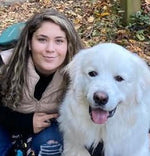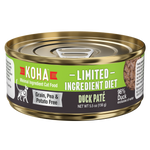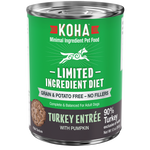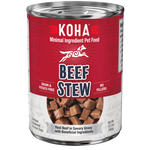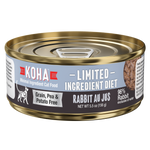
How to Read Your Pet's Nutrition Label (The Right Way!)
Choosing the right food for your dog or cat can be a daunting task. Even more challenging is understanding the nutritional label on their food!
You may ask yourself: How do I know if my dog’s food has all the nutrients she needs? Should my cat be eating a low fat diet? How do I know what’s really in my pet’s food?
The truth is, nutrition labels can be confusing - that’s why KOHA is here to help!
In this blog we’ll cover:
- Order of Ingredients (and Ingredient Splitting)
- Product Name and Why it’s Important
- Guaranteed Analysis vs. Dry Matter Analysis
- Balancing Proteins, Carbs, and Fats in Your Pet’s Diet
Ingredient List and Ingredient Splitting
If you aren’t already aware, the order of ingredients on a product is listed by highest to lowest percentage of food. That means the first ingredient makes up the highest composition of the food; ideally, it should be an animal protein. Meanwhile, the last ingredient is typically very minimal in the food.
What this means is that the first five ingredients are crucial to look at. They’re going to give you the best picture of what is really in your pet’s food. Be careful not to fall for a common practice called ingredient splitting. This is where a pet food manufacturer splits up a non-essential or filler ingredient, such as a potato, into several ingredients in order to be able to list a more important ingredient, such as chicken, first. You can read more about ingredient splitting and how to identify it, here.
That being said, make sure to look through all of the ingredients in your dog or cat’s food, in order to avoid potential filler ingredients that may be hidden. If your dog or cat has food allergies, this is especially important to avoid accidentally feeding them a digestive irritant. There are many common ingredients that can actually be problematic for pets - check out this blog for more information.
All of this information may seem a bit overwhelming - but don’t worry! If you’re concerned about what you’re feeding your pet, the name of the recipe is a good indicator.
The Importance of Product Name
The name of a pet food is a great way to determine exactly what the food is made of. That’s because The Association of American Feed Control Officials, or AAFCO, has guidelines on what you can name a product, based on the percentage of ingredients within the product. Be aware of any pet foods with names that fall under one of these categories:
- 3% Rule: If a pet food name says “with (protein source)”, such as "with chicken” or "with beef”, the manufacturer is only obligated to include 3% of the protein within the product. In this case, there is likely very little of this ingredient in the actual food. It’s important to beware of filler ingredients that could be comprising a majority of the recipe.
- Flavor Rule: Foods that use the word “flavor” in the product name have no percentage requirement for a given ingredient. That means a manufacturer could name their product “Chicken Flavor Dog Food” and include little to no actual chicken in the food. Products like these are often completely filler-based.
With this knowledge in mind, be sure to pay attention to the name of your pet food as well as the ingredients within it. Next comes the nutritional information, that will give you even more insight into what you’re feeding your pet.
As Fed versus Dry Matter Analysis
AAFCO requires pet food companies to display the nutritional information of a product in the “As Fed” format. That means exactly what goes into your dog or cat’s bowl. The problem arises because this format does not take into consideration moisture in the food. Kibble often appears to have a higher protein content than wet food, because wet food inherently has a higher moisture content.
To get the true nutritional content for a product, you’ll want to look for a “Dry Matter Analysis”. This analysis removes all moisture from the equation, and is much more accurate in terms of proteins, fats, and carbohydrates.
Let’s take an example:
Let’s say you are at the pet store, and you see a bag of dry food and a can of wet food. You’re not sure which to buy, so you look at the nutritional labels. Under the As Fed Percentage, you see this:

Looking at this information alone, you’d almost certainly opt for the kibble, with a significantly higher protein content. However, when you exclude moisture and look at the Dry Matter Analysis, there’s a big change:

As you can see, the wet food in this instance is significantly higher in protein than the kibble. But if you were to look at the As Fed Percentage alone, you would think otherwise. Always be sure to accurately compare the food you’re purchasing, to make sure it’s the best choice for your furry friend.
What Should My Pet’s Diet Be Comprised Of?
You should prioritize a high protein diet, with minimal filler ingredients. Ideally, you’d avoid any food that is primarily made up of unnecessary carbohydrates (i.e. potatoes, corn, flour, soy, etc). If your dog or cat is overweight, you’ll also want to prioritize feeding them a low fat diet.
A good balance of minerals and vitamins within their diet is important as well. Dogs and cats each have different dietary necessities, and underlying conditions will impact exactly what percentage of their diet should be comprised of specific nutrients. Over or underfeeding nutrients can be problematic and result in health problems. Always consult with your trusted veterinarian before making any major changes to your pet’s diet. They can advise you regarding your dog or cat’s dietary needs.
If you need help choosing the right food for your pet, check out our Recipes Guides for Dogs and Cats. They have all of the information you need to pick out their perfect recipe for your furry friend.
Table of Contents
- Choosing a selection results in a full page refresh.
- Press the space key then arrow keys to make a selection.
